Imagine embarking on a journey to find the perfect four-legged companion, someone who will bring joy and love into your life. Picture a breed that is as lively as a ray of sunshine, yet as loyal as a steadfast companion. Look no further than the Flat-Coated Retriever.
With their medium-length, flat coats and intelligent, energetic personalities, these English-originated dogs have captivated the hearts of many. But there is so much more to discover about this delightful breed.
From their size and appearance to their temperament and adaptability, there's a world of information and characteristics waiting to be explored. So, are you ready to uncover the wonders of the Flat-Coated Retriever?
Key Takeaways
- Flat-Coated Retrievers originated in mid-19th century England and were developed by crossing several breeds.
- They are medium to large-sized dogs with an elegant, strong, and athletic build.
- Flat-Coated Retrievers are intelligent, affectionate, and form strong bonds with their families.
- They require regular exercise, a balanced diet, and proper grooming to maintain their health and well-being.
Origin and History
The origin and history of the Flat-Coated Retriever breed can be traced back to England. This versatile breed was developed in the mid-19th century by crossing various retriever breeds, such as the Newfoundland, Labrador Retriever, and Collie, to create a dog that excelled at retrieving game from land and water.
The breed gained popularity among hunters and sportsmen due to its exceptional retrieving abilities, intelligence, and stamina. The Flat-Coated Retriever quickly became a favorite among the British upper class and was recognized by the Kennel Club in 1915.
Throughout the years, the breed has remained relatively unchanged, maintaining its distinctive appearance and working abilities. Today, the Flat-Coated Retriever isn't only an excellent working dog but also a beloved family companion.
Size and Appearance
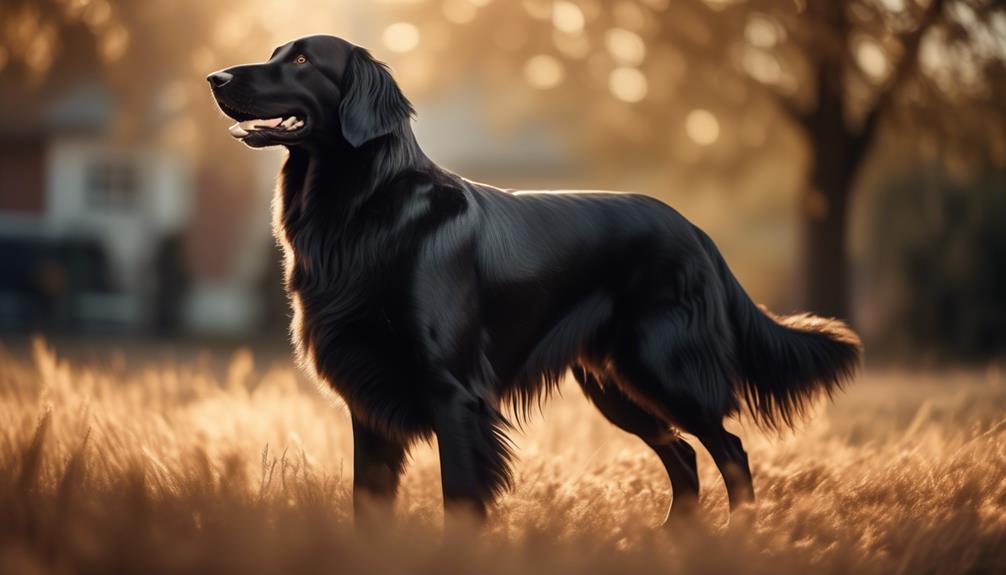
With its medium to large size and distinctive appearance, the Flat-Coated Retriever is an impressive and eye-catching breed. These dogs have a strong, athletic build and a well-balanced body. They stand at around 22-24 inches tall at the shoulder and weigh between 55-75 pounds. Flat-Coated Retrievers have a beautiful, shiny, and dense coat that comes in solid black or liver color. Their coat is medium in length and lies flat against their body, providing protection from water and cold weather. Their expressive eyes are dark brown and their ears are set high and hang close to their head. Overall, their appearance exudes elegance, strength, and grace.
To help you visualize the size and appearance of the Flat-Coated Retriever, here is a comparison table:
| Characteristic | Flat-Coated Retriever |
|---|---|
| Size | Medium to large |
| Height at shoulder | 22-24 inches |
| Weight | 55-75 pounds |
This table highlights the key measurements that define the size of the breed. As you can see, the Flat-Coated Retriever falls into the medium to large category, making them a substantial and robust dog. Their size, combined with their attractive appearance, makes them a striking breed that is sure to turn heads wherever they go.
Temperament and Personality
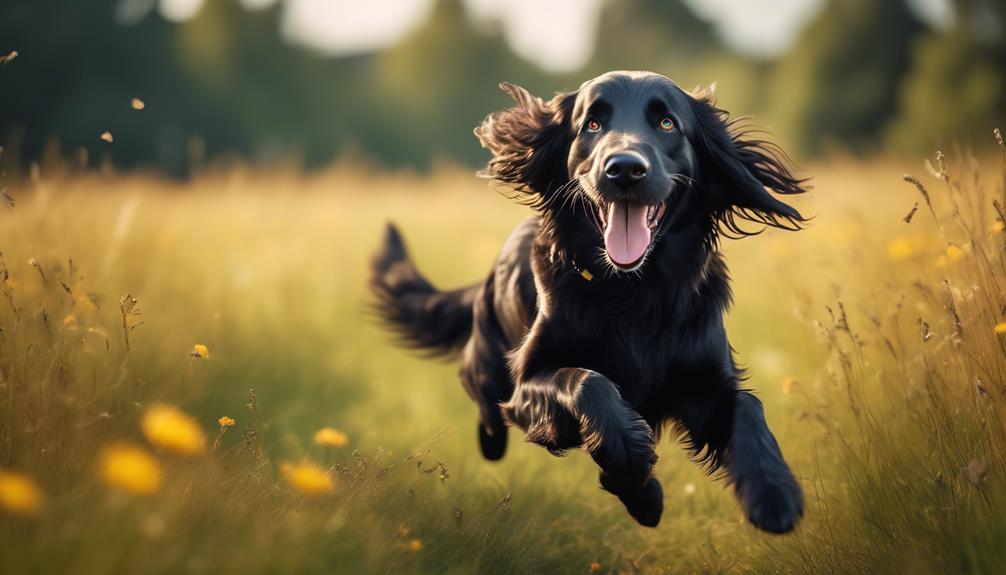
Moving on from discussing the size and appearance of the Flat-Coated Retriever, let's now explore the fascinating aspect of their temperament and personality.
This breed is known for their intelligence, energy, affection, and playfulness. They're highly intelligent dogs, making them easy to train and quick to learn new commands.
Their energy levels are also high, so they require regular exercise to keep them happy and healthy.
Flat-Coated Retrievers are known for their affectionate nature, and they form strong bonds with their families. They're great with children and other pets, and they're generally friendly towards strangers.
With their playful nature and loving personality, Flat-Coated Retrievers make excellent companions for novice owners or families looking for an active and loving pet.
Health Concerns and Care Tips
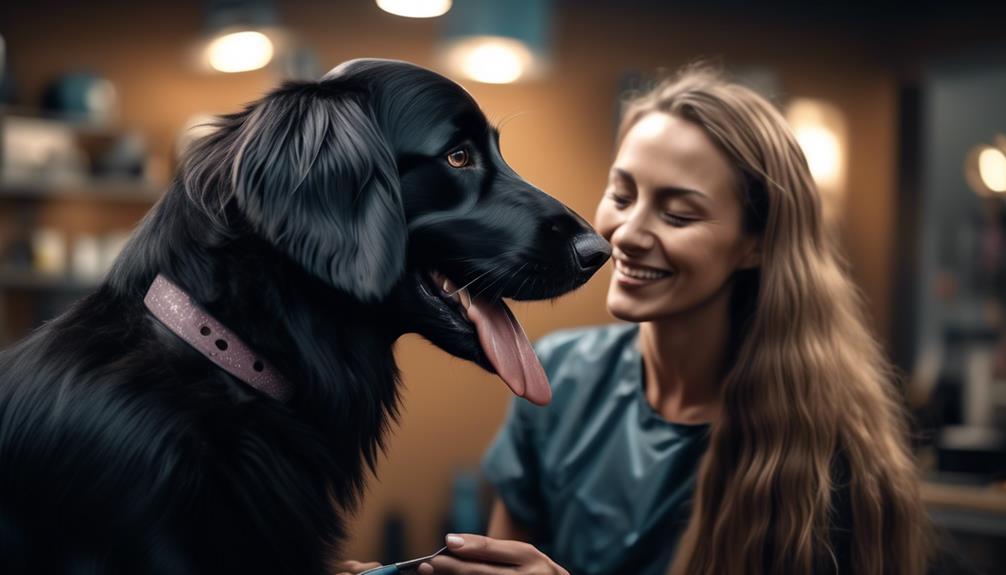
To ensure the health and well-being of your Flat-Coated Retriever, it's essential to be aware of common health concerns and follow proper care tips.
Flat-Coated Retrievers are generally a healthy breed, but like all dogs, they can be prone to certain health issues. One potential concern is hip dysplasia, a condition where the hip joint doesn't develop properly. Regular exercise, maintaining a healthy weight, and providing joint supplements can help prevent or manage this condition.
Another common health issue in Flat-Coated Retrievers is cancer, particularly of the bone or spleen. Regular check-ups with your veterinarian and early detection are crucial for successful treatment.
Additionally, keep an eye out for eye problems such as cataracts or progressive retinal atrophy. Proper care includes providing a balanced diet, regular exercise, grooming, and regular visits to the vet for vaccinations and check-ups.
Feeding and Nutrition
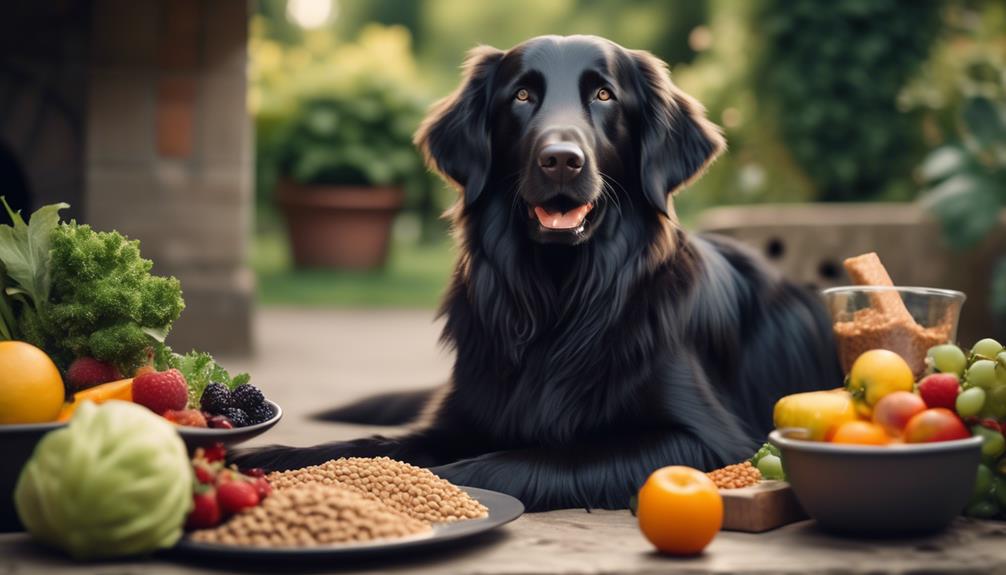
To ensure optimal health and well-being for your Flat-Coated Retriever, it's crucial to provide them with proper feeding and nutrition. Here are some important points to consider:
- Quality of Food:
- Choose a high-quality dog food that's specifically formulated for large breed dogs.
- Look for a balanced diet that includes a good mix of protein, carbohydrates, and fats.
- Feeding Schedule:
- Divide your dog's daily food intake into two meals to prevent overeating and promote digestion.
- Follow the recommended portion sizes provided by the dog food manufacturer based on your dog's weight and activity level.
Exercise and Activity Needs
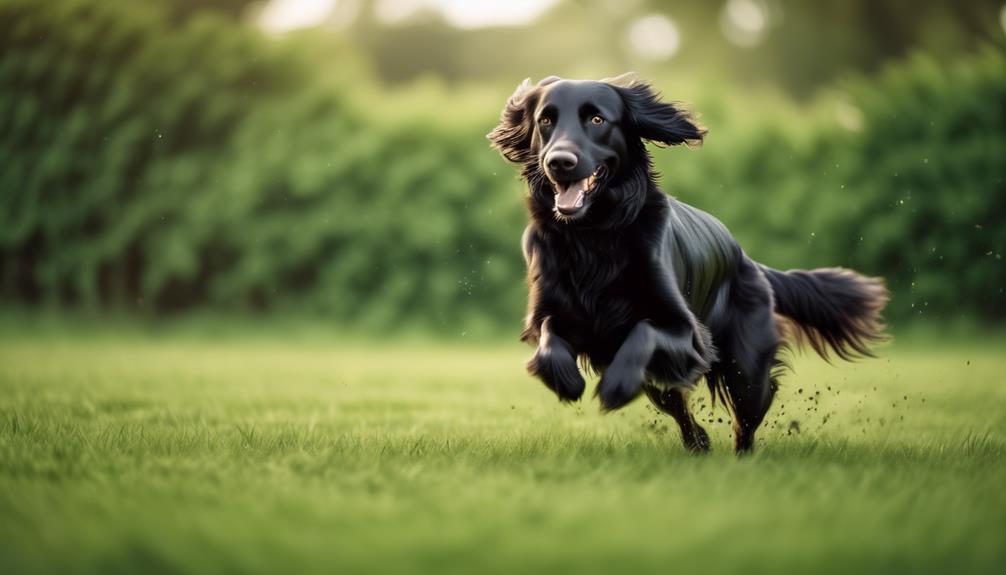
When it comes to the exercise and activity needs of a Flat-Coated Retriever, it's essential to provide them with regular and vigorous physical exercise to keep them happy and healthy. These dogs have high energy levels and a playful nature, so they require plenty of opportunities to burn off that energy.
A minimum of one hour of exercise per day is recommended for this breed. This can include activities such as long walks, jogging, hiking, swimming, or playing fetch. They also excel in various dog sports like agility, obedience, and flyball.
Mental stimulation is equally important, so incorporating training sessions, puzzle toys, and interactive games into their routine is beneficial. By meeting their exercise and activity needs, you can ensure that your Flat-Coated Retriever remains physically fit, mentally stimulated, and content.
Coat Color and Grooming
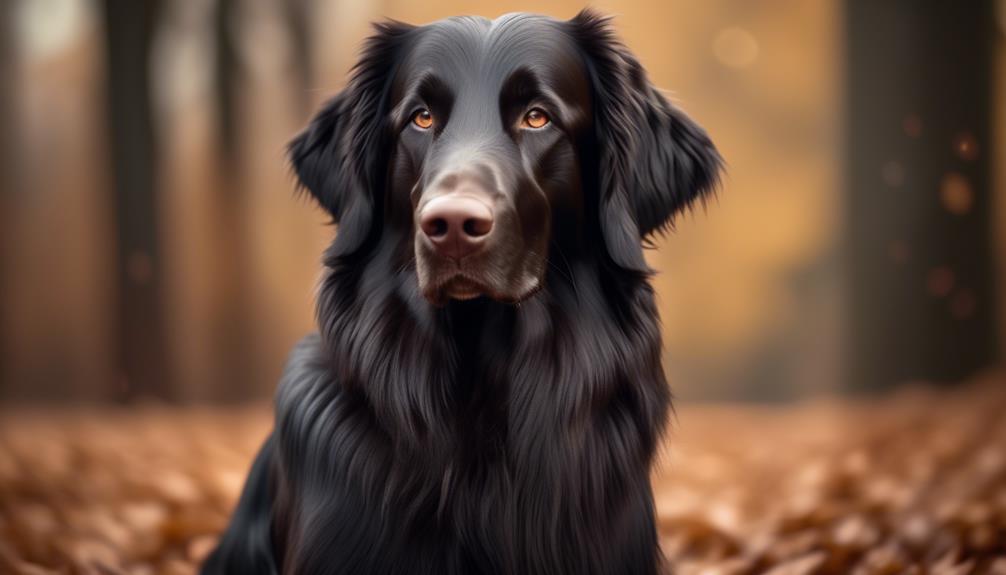
The coat color and grooming of a Flat-Coated Retriever are important aspects to consider when caring for this breed.
Flat-Coated Retrievers have a dense, medium-length coat that's typically black or liver in color.
Grooming this breed requires regular brushing to prevent matting and to keep their coat looking its best.
In addition to regular brushing, Flat-Coated Retrievers should have their ears checked and cleaned regularly to prevent ear infections.
When it comes to grooming, it's also important to note that Flat-Coated Retrievers are moderate shedders, so be prepared for some hair around the house.
Interaction With Children and Other Pets
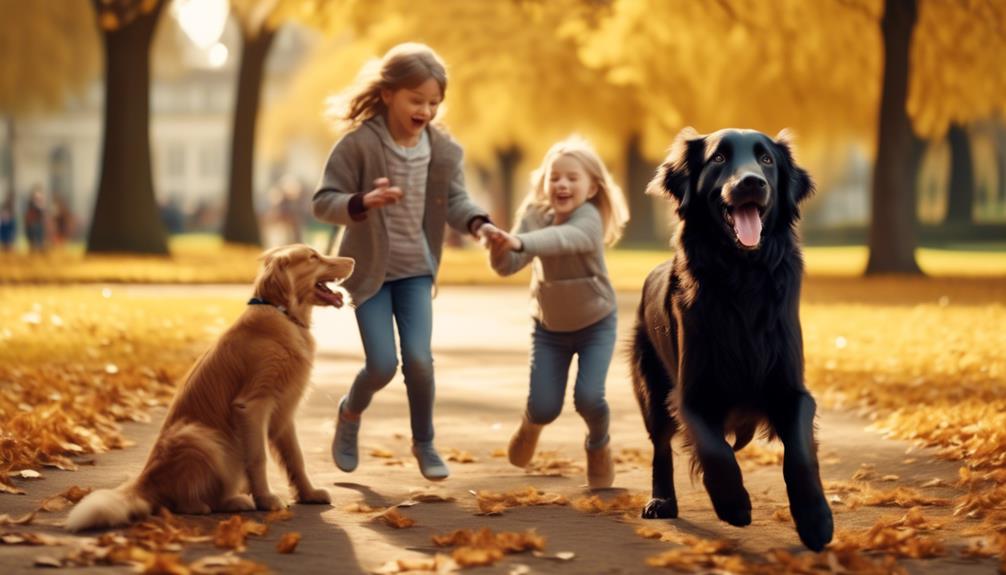
Now let's explore how Flat-Coated Retrievers interact with children and other pets, an important aspect to consider when bringing this breed into your home.
Flat-Coated Retrievers are known for their affectionate and friendly nature, making them excellent companions for children. They're patient, gentle, and tolerant, making them suitable for families with kids of all ages. These dogs love to play and are always up for a game of fetch or a run in the park.
When it comes to other pets, Flat-Coated Retrievers generally get along well with them. They've a friendly and social disposition, making it easier for them to form positive relationships with other animals, including cats and other dogs. However, as with any breed, proper socialization and training are important to ensure harmonious interactions between your Flat-Coated Retriever and other pets in your household.
Training and Intelligence
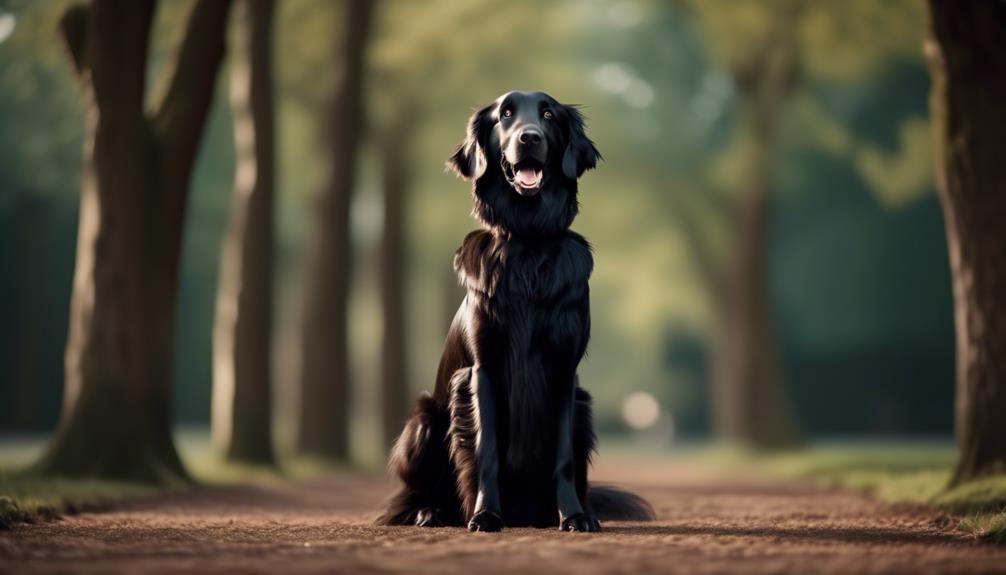
Training and intelligence are key aspects to consider when bringing a Flat-Coated Retriever into your home. These dogs are highly intelligent and eager to please, making them excellent candidates for training. Here are some important points to keep in mind:
- Flat-Coated Retrievers have a strong desire to learn and excel in obedience training.
- They respond well to positive reinforcement methods, such as treats and praise.
Early socialization is crucial to ensure they develop good manners and get along well with other animals and people.
- These dogs have a natural instinct for retrieving, so incorporating games of fetch into their training can be both mentally stimulating and physically engaging.
Consistency and patience are key when training a Flat-Coated Retriever, as they can be sensitive to harsh training methods.
Adaptability to Living Environments
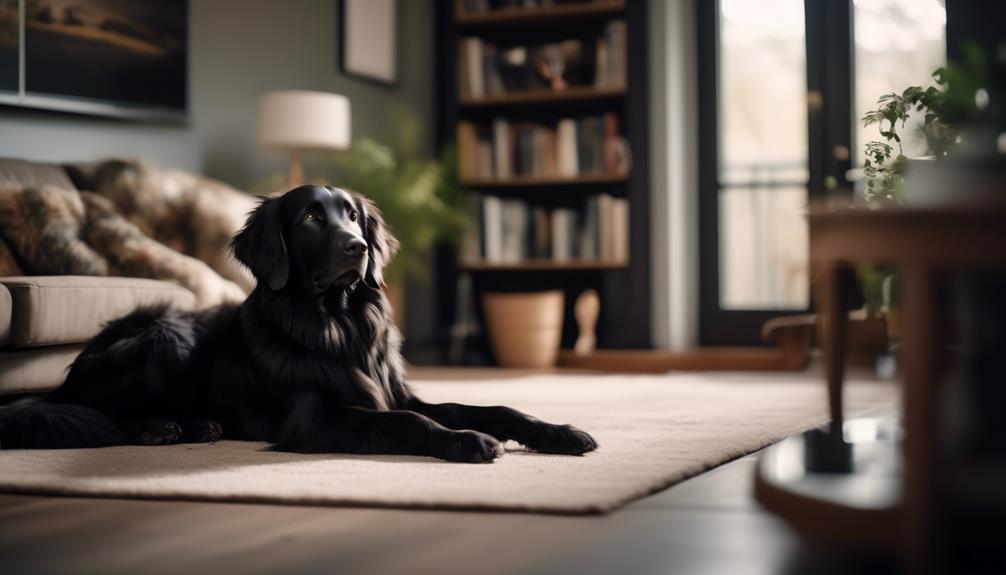
When considering the adaptability of the Flat-Coated Retriever to various living environments, it's important to understand their unique needs and characteristics.
Flat-Coated Retrievers are adaptable dogs that can thrive in different living situations, including apartment living. However, they do require regular exercise and mental stimulation. They're energetic dogs that need plenty of physical activity to stay happy and healthy.
Flat-Coated Retrievers are also known for their intelligence, which makes them suitable for novice owners. They're highly trainable and eager to please, making them easy to live with. Additionally, they're generally friendly and social dogs, getting along well with other pets and strangers.
With the right care and attention, the Flat-Coated Retriever can adapt well to different living environments and make a wonderful companion.
Resources and Support for Flat-Coated Retrievers
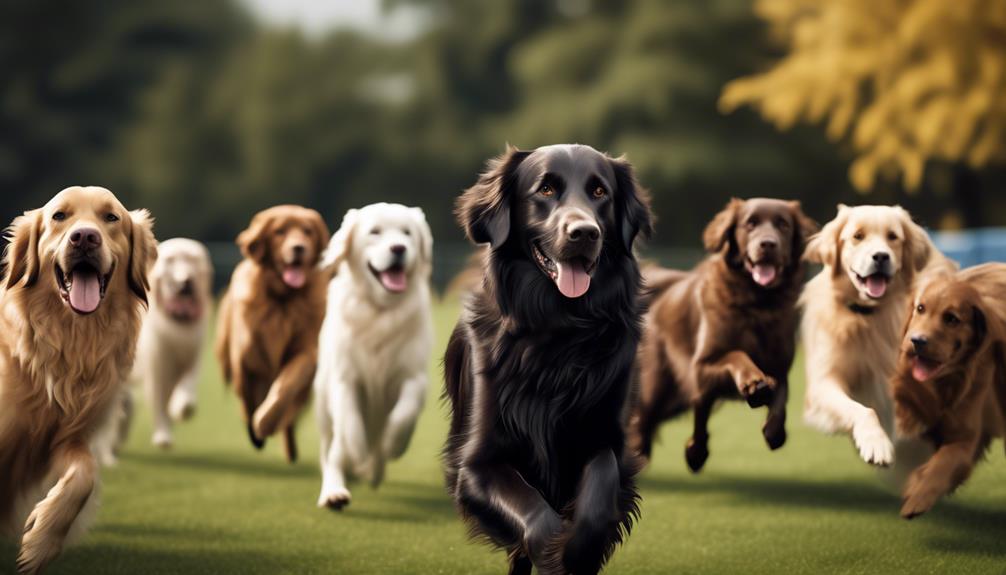
To further support and enhance your experience with Flat-Coated Retrievers, there are various resources and support systems available to assist you in understanding and caring for this wonderful breed. Here are two key resources to consider:
- Breed Organizations: Joining breed organizations such as the Flat-Coated Retriever Society of America or the Flat-Coated Retriever Society in the United Kingdom can provide you with access to a wealth of information, including breed standards, health resources, training tips, and networking opportunities with other Flat-Coated Retriever enthusiasts.
- Rescue Groups: If you're interested in adopting a Flat-Coated Retriever or need assistance with rehoming your own dog, rescue groups specializing in this breed can be a valuable resource. These organizations can help match you with a suitable dog, provide support and guidance throughout the adoption process, and offer ongoing support for any questions or concerns you may have.
Frequently Asked Questions
Are Flat-Coated Retrievers Good Guard Dogs?
No, flat-coated retrievers are not typically good guard dogs. While they may bark to alert you of strangers, they are generally friendly and outgoing, making them better suited for being family companions rather than guard dogs.
How Do Flat-Coated Retrievers Handle Being Left Alone for Long Periods of Time?
Flat-Coated Retrievers may struggle with being left alone for long periods of time. They are affectionate and thrive on human companionship. If left alone, they may become anxious or develop destructive behaviors. Providing mental stimulation and regular exercise can help alleviate these issues.
Can Flat-Coated Retrievers Live in Hot Climates?
Yes, they can live in hot climates, but they may struggle with the heat due to their thick coats. Make sure to provide plenty of shade, fresh water, and opportunities for them to cool down.
Do Flat-Coated Retrievers Have a Strong Prey Drive?
Yes, Flat-Coated Retrievers do have a strong prey drive. They were originally bred for hunting and retrieving game, so it's in their nature to chase and capture small animals.
Are Flat-Coated Retrievers Prone to Separation Anxiety?
Yes, flat-coated retrievers can be prone to separation anxiety. They are loyal and affectionate dogs that form strong bonds with their owners. Being left alone for long periods can cause them distress.
What Are the Main Differences Between Flat-Coated and Curly-Coated Retrievers?
Flat-coated retrievers are known for their sleek and shiny black coats, while curly-coated retrievers have dense, curly hair. The curlycoated retriever characteristics also include a more reserved and independent nature, compared to the friendly and outgoing personality of the flat-coated retriever. Both breeds excel as hunting and retrieving dogs.
Conclusion
In conclusion, if you're looking for a furry companion that's both lively and affectionate, the Flat-Coated Retriever is an ideal choice.
With their medium-length, flat coats and adaptable nature, they can thrive in any living environment.
Their friendly and easy-going temperament makes them well-suited for novice owners, and they're great with children and other pets.
So why not add a Flat-Coated Retriever to your life and let their love and energy brighten your days, like a ray of sunshine in a cloudy sky.




